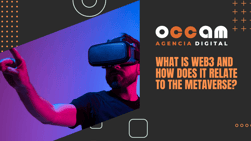Index Content
A decentralised system... An application that we use on a regular basis... What is it exactly?
In this post, we are going to explain what a decentralised application or DApp is. Before we start and find out what it is, first you need to know clearly what a centralised application is. It is an application that you use on the internet on a regular basis, a system controlled by a single or central entity, such as a company, an institution or an individual. In any case, this entity hosts the system in its facilities and offers a service through the cloud. The institution has full control of all the components and layers of the architecture, so the user has to assess whether this entity is reliable or not.
For example, the applications you use when you access your bank or buy clothes in an online shop. That's one example. Now, what we are interested in is to know what the DApp is all about.
Come on, read on, because now comes the best part. Let's get started!
what is a DAPP and what is it for? The million-dollar question
They are decentralised applications that use blockchain technology so that users can relate directly to each other, close deals without the presence of a central entity and with multiple advantages for the user:
- It is a very secure system thanks to the encryption of blockchain technology, so it prevents data manipulation or information theft. As it is not hosted in a central database, it is very difficult to suffer a cyber-attack of these characteristics, so security is much greater than in any centralised application.
- It is a stable system thanks to the presence of the nodes. If one part of the network goes down, it does not affect the rest, since it is distributed and not on a central server.
- The information cannot be traced by any central entity, so it avoids spamming by companies to launch campaigns or commercial offers.
- It facilitates the creation of agreements through Smart contracts in which clauses or conditions are fulfilled automatically.
- It provides much more reliable data records, as users can access the blockchain to track their transactions.
- It can be used on personal computers, smartphones, tablets or websites.
The origin of DApps dates back to 2001, when the first decentralised applications were launched for the purpose of file sharing, as well as P2P networks: BitTorrent, eMule, etc.
But what makes these applications a decentralised system?
4 characteristics of decentralised applications
Now that we know what a DApp is, it is time to take the next step and talk about its characteristics:
- Decentralisation
Decentralising an application means eliminating its dependence on a system or server from which everything is controlled, which allows applications to work with greater tolerance to errors.
- Security
Thanks to the distributed nature of the nodes, attacking the information stored on the blockchain is practically impossible. It ensures that the data can only be seen by those who create it, as well as the rest of the users who intervene to verify its validity.
- Open source
This means that the source code is made freely available to everyone to facilitate its adaptation to different contexts. This opens up a huge range of possibilities and makes the applications very transparent.
- Blockchain
DApps interact on this technology to execute their smart contract, which generates an input of information on the blockchain. This data is encrypted in order to increase transparency and is stored on the blockchain.
Centralised applications (Apps) VS decentralised applications (DApps)
We are sorry to tell you that there is no magic wand that is going to help you decide between App or Dapp, but you can know their main differences, the secret is to keep reading and take the next step:
- Backend: application logic
It is centralised in traditional apps and decentralised in DApps. In the latter case, the backend is related to a smart contract executed on the blockchain. It is the programming of the smart contract that guarantees the functioning of the decentralised app.
- Frontend: the interface
It allows users to interact with the application and has a multitude of graphical resources that can be used by both types of applications, from frameworks such as QT to interactions written in HTML5.
In addition to these two main characteristics, you must take into account the storage of the information. In traditional applications it is centralised, that is, it is stored in servers that are controlled by third parties. However, in DApps, the storage is decentralised and the interactions are stored in the blocks of the chain in a cryptographic way. They provide much more security, to the point that if your computer crashes, you can recover all the information just by using the decentralised application on another device.
3 types of decentralised applications: did you know them?
Now that you know what they are, what their advantages and characteristics are, it is time to classify decentralised applications:
- DApps with their own blockchain. They have their own system and do not need to rely on another blockchain for their execution. Do you want some examples? Here they go: Litecoin, Ethereum and Monero, among many others.
- DApps that depend on a blockchain for their operation. They use their own tokens or those of the blockchain on which they operate and depend on a blockchain to be able to run. An example: Golem.
- DApps that use decentralised applications that depend on a blockchain (previous type) in order to function. Here is an example: Safe Network, supported by Omni Layer in order to generate Safecoin.
everything clear so far?
Additional information on DApps
Let's take a practical case as an example of the use of DApps:
- "When the General Elections of my country are approaching, I get nervous, I don't trust my government and I get so down that I think about not voting again, I swear".
- Perhaps voting by all citizens via the internet should be considered.
- "And what would that solve if the votes were counted by a central system controlled by the government?
- You are right, it is very insecure. Anyone could manipulate these servers and change the results. If the government that controls this entity is not trustworthy, the elections would not be fair.
- "And how can this problem be avoided?".
- A decentralised application could be used.
- "And how do you do that?
- A decentralised voting application is created that works as follows: there is a network of computers distributed around the world that have a copy of the application. If a citizen votes over the internet with a DApp, all the computers in the distributed system will have a copy of it. This is achieved with a Peer-to-Peer network, thanks to the miners and the nodes.
- "Of course, this would make it virtually impossible to manipulate the votes, but how does a node and a miner work?
- A node verifies that the votes received in a transaction are correct and sends them to the rest of the nodes. In other words, it will replicate the information throughout the network. The mining nodes, however, will operate mathematically to include the data that citizens enter in the copy of all the votes. These miners will introduce blocks in the blockchain, where the transactions or set of votes of the citizens are incorporated. In short, the miners introduce these votes in the official copy of the network and the nodes send the information to the entire network".
- "But isn't it too complicated?
- At first, it may seem complex, but it is a secure process carried out by professionals. Every computer will have a copy of the citizens' votes. And if someone tries to alter one of the copies, the other nodes will realise that 'you have a copy that doesn't match the others'. So they will identify that there is a node that is entering fake votes.
- "It's fantastic, this system provides the security, integrity and transparency that we all need in this country.
do you have any doubts about how DApps work? Who should you turn to if you want to create a decentralised application?
Consult all your doubts with the professional team at Occam Agencia Digital.





